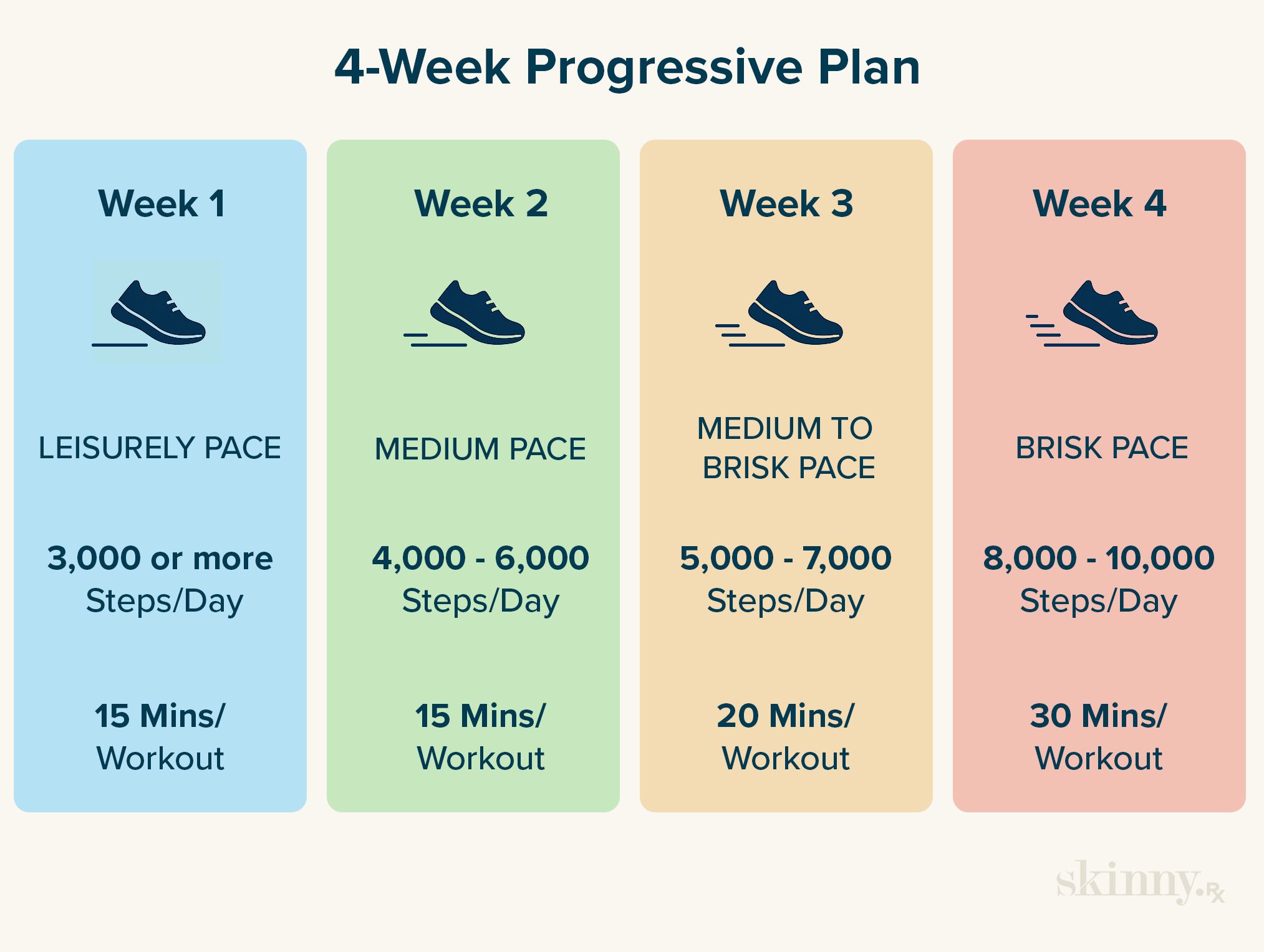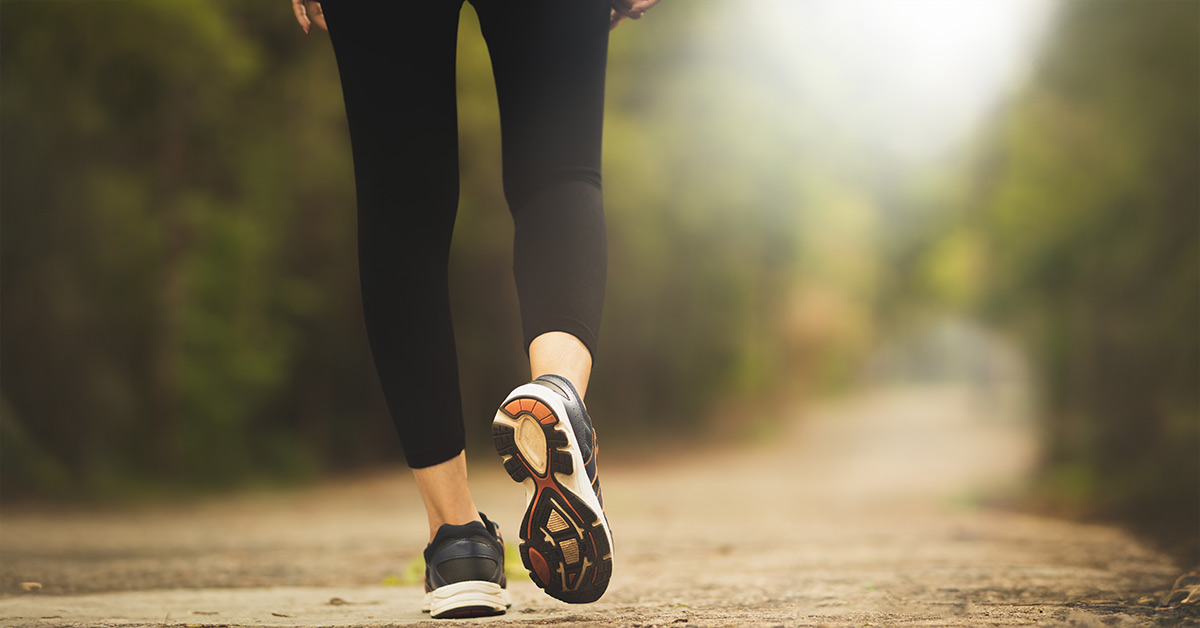
Key Takeaways
- Walking works synergistically with semaglutide, enhancing weight loss results by supporting healthy habits and preserving lean muscle.
- A structured walking routine with gradual step and intensity increases helps semaglutide users stay consistent and avoid injury.
- Walking can offset common side effects of semaglutide, such as fatigue and muscle loss, while promoting long-term fitness habits.
- You can walk anytime, but walking after meals may help with blood sugar regulation and digestion.
- Don’t rely solely on the scale—track your progress through energy, movement ease, clothing fit, and step consistency.
Why Walking is Semaglutide’s Perfect Partner
Let’s be clear: When it comes to achieving the goals you’ve set for yourself on your weight loss journey, semaglutide alone will only get you so far. Creating healthy habits that last requires both an adjustment to your food choices and an exercise routine you can stick to.
Luckily, walking and semaglutide go hand-in-hand. While you adjust to the effects of your GLP-1 —that’s glucagon-like peptide-1 agonists, a class of drugs originally developed to regulate blood sugar—medication, you also need an exercise routine that is simple, straightforward, and synergistic with your goals.
This guide will explain the science behind why walking works wonders, plus how often (and how far) you should walk for weight loss on semaglutide.
The Science Behind Walking and GLP-1 Medications
Believe it or not, walking and semaglutide have a lot in common. Both serve as accessible interventions that help you improve your health; medications like Ozempic and Wegovy regulate your appetite and curb cravings so you can make smarter choices in the kitchen. Walking helps you take your first steps (sorry, had to) toward an active, movement-focused lifestyle.
How Walking Helps Semaglutide Work Better
Exercise and dietary changes are like seasoning with salt and pepper—both add flavor individually, but they work best together.
Consider this landmark study from 2011 which has been cited by over 600 other papers. Researchers found that adding exercise or changing eating habits both improved body composition, but participants who incorporated both experienced the biggest benefit.
One big thing: In the study above, participants were divided into different groups that changed their diets, added exercise, both, or neither. The “diet-only” group lost more than double the weight of the “exercise-only” group! So, if your semaglutide medication is helping you make changes in the kitchen, you’re already well on your way.
Let’s look at what other science has to say and dig into the specifics.
Synergy With Your Medication
Habits, behaviors, or interventions in general are considered synergistic if they help achieve the same goal, or augment each other in some way.
Preventing Muscle Loss
When you’re taking semaglutide for weight loss, the scale can shift quickly. Along with rapid weight loss often comes the risk of losing your valuable lean muscle as well. Luckily, even small amounts of exercise, such as a walking routine for weight loss, can mitigate or prevent this.

Clinically Guided GLP-1 Treatments, Personalized for You
Compounded semaglutide and tirzepatide. Clinically guided to help you lose weight safely and sustainably. Take a quick assessment to see if it’s right for you.
Walking Guidelines for Semaglutide Users
As an accessible, low-intensity form of exercise, walking is an activity you can easily pair with your weight loss endeavors through semaglutide. However, determining the correct amount of walking for weight loss, as well as how often and how quickly you walk, is crucial.
- Beginner: Aim for one dedicated walking workout per day, at a leisurely pace, for 15 minutes or more.
- Intermediate: Hit two walking workouts a day at a moderate pace for up to 20 minutes each.
- Advanced: Set a step goal and stick to it, while also performing two brisk walks per day for 30 minutes a day or more.
Remember this: You can definitely walk for a workout, but you also use your legs around the house, office, and basically everywhere else. You aren’t starting from scratch.
Timing Matters: When to Walk for Best Results
Here’s the good news: When you walk for weight loss while using semaglutide, it won’t dramatically affect your results. If you lead a busy life—juggling work, duties at home, and socializing with friends can certainly feel like a workout of its own—get your exercise in whenever you’re able.
That said, if you have the ability to exercise at your convenience, there are some factors to consider.
Morning vs. Evening
For athletes, exercising at different times of day can affect performance. Walking in the morning is a popular option for those who work long hours sitting down, but you may need to get up earlier than you’re used to if you plan on walking a long distance.
Athletes or highly active individuals may find they perform better later in the day after they’ve eaten a meal or two. Additionally, some folks find exercising close to bedtime disrupts the ability to fall asleep—for others, it’s a sleep aid. If you have the time to spare, it’s worth experimenting a bit.
After Eating vs. Fasted
Fasted cardio, AKA hitting the track, treadmill, elliptical, or bike on an empty stomach, has been a popular technique for weight loss for years, with proponents claiming it encourages your body to use stored fat for fuel instead of food.
However, science tells us this phenomenon doesn’t make much of a difference long term. On the other hand, studies do tend to show that walking after eating can regulate blood sugar and improve digestion.
Here’s the bottom line: Walk when you’re consistently able to do so. If you have the luxury of choice…
- Walking for weight loss in the morning, before breakfast, might help give you some extra energy throughout the day by improving circulation and elevating your mood.
- Walking after lunch or dinner can help settle your stomach if you feel bloated, gassy, or sluggish.
Coordinating With Your Injection Schedule
Injecting semaglutide, whether you’re on Ozempic, Wegovy, or another brand, shouldn’t affect your walking workouts very much. However, when it comes to injection sites, you may not want to inject your thighs if you’re planning on doing a walking workout shortly after.
Overcoming Common Challenges
Walking for weight loss on semaglutide comes with its challenges, make no mistake. The good news is you can tackle most of them without too much trouble. Here’s your cheat sheet.
Fatigue or Low Energy
We hear it all the time—”A morning workout provides energy all day!” But if you’re new to exercise, you might find yourself exhausted, not invigorated, by your new routine.
This is common, and the good news is that if you’re exercising to lose weight on semaglutide, your body will usually adapt pretty quickly. Your first walking workout is going to be the hardest; every session after that should get easier and more bearable. That’s your body adapting to a new challenge.
That said, chronic fatigue or low energy is no bueno for sticking to a workout routine. Let’s run through some common causes, and what you can do to work around them while you’re on semaglutide:
- Poor Sleep: Undersleeping or interrupted sleep can massively impact your energy levels throughout the day. Do your best to stick to a regular sleep and wake schedule, and shoot for at least seven hours of shut-eye a night.
- Vitamin/Mineral Deficiencies: Low levels of vitamin D, B12, and more have been shown to negatively affect exercise performance. Consider a multivitamin if you aren’t taking one and don’t have a diverse, whole-food centric diet.
- Stress: Stress, studies show, reduces “exercise tolerance,” or your desire to engage in physical activity. Managing stress is an intricate topic, but in the short term, try guided meditation, mindfulness, or even music to help soothe your system.
- Chronic Conditions: Certain health conditions, like hypothyroidism or diabetes, can cause persistent tiredness. If you suffer from a medical issue, consult with your physician about how to mitigate fatigue.
Joint Pain
If you’re experiencing joint pain while trying to get into walking, you’ll need to take a comprehensive look at your health—and your shoe rack.
Walking for weight loss on semaglutide is a relatively low-impact form of physical activity. Still, it does put stress on your joints, which you may be quite sensitive to if you’re not regularly active already. Here’s what you can do:
- Take shorter, more frequent walks if your joint pain worsens over long durations.
- Go to a running store to get fitted into a pair of shoes with the appropriate amount of cushion and arch support for your body.
- Try walking on a slight incline! This actually reduces the amount of force on your joints. Conversely, walking downhill is more stressful.
One big thing: If you have a chronic health condition that contributes to or creates joint pain, your first stop should be at your physician’s office to seek an informed recommendation.
Tracking Progress Beyond the Scale
The scale can be scary. Most people have at one point or another stepped onto one and felt anxious, embarrassed, or downright afraid of what they’d see—who knew a tiny number on a tiny screen could feel so massive and overbearing.
Research tells us that anxiety about weighing yourself is quite common. While it is important to be diligent about monitoring changes in your body while you’re on semaglutide, the scale isn’t the only thing you should be looking at.
Non-Scale Victories Matter
You probably aren’t on your weight loss journey for fun. Medications like Ozempic and Wegovy help you reclaim your health and reignite your physical fitness.
The number you see on the scale helps you understand if what you’re doing is having an effect on your body composition (your ratio of body fat to muscle, bone, and so on), but you should also find victories in:
- How your clothes fit
- How easy it is to perform household chores
- The way you feel when you look in the mirror
- Your internal health markers, like cholesterol and blood pressure
And, of course, how routine and even fun it is to get your steps in.
Keep tabs on the scale (and adjust your eating or exercise habits accordingly), but remember that the number you see is just data. It’s not a “health score,” and it certainly doesn’t say anything about your worth as a human being.
Using Step Counters Effectively
Step trackers also provide a clear, concise form of quantitative feedback about what you’re doing. Walking for weight loss is a respectable, but vague, goal. While you’re taking semaglutide for weight loss, keeping track of your steps helps you to know:
- How consistent your daily physical activity is
- A ballpark threshold of activity to hit each day
- How your cardiovascular endurance is changing
Nearly all smartphones come with a built-in step tracker, and there are plenty of apps available that will keep tabs on it as well. If you use your walking workouts for weight loss as an escape from the screen—most of us could certainly use a digital detox—you can also pick up a standard pedometer.
When to Increase Intensity
There’s a key difference between physical activity and exercise: The latter is intentional, challenging, and goal-oriented. If you stick to your walking workouts and don’t change or intensify them, some of the fitness benefits may start to slip away.
Increase your intensity by adding duration to your workouts, kicking up the pace, walking uphill, or even incorporating walk-jog intervals. Once your walking workouts are no longer tiring, you don’t break any sort of sweat, or your heart rate stays low, it’s time to up the ante.
A caveat that matters: There is a ceiling to walking for your health. A comprehensive analysis in The Lancet, one of the world’s leading medical journals, found that increasing daily steps up to 8,000-10,000 per day continued to reduce all-cause mortality risk (in simple terms, improved general health longevity). Beyond that, continued benefits aren’t guaranteed.

Ready to take the next step?
Real progress starts with the right support. See if compounded semaglutide or tirzepatide could be your next step toward lasting results.
Sample Walking Plans for Semaglutide Users
Even when it comes to something as simple as walking, getting into the swing of things is easier said than done. That’s where a progressive plan comes in. This workout is perfect for any semaglutide user looking to start making changes ASAP.
4-Week Progressive Plan
If you want to take the guesswork out, here’s a simple four-week walking regimen for weight loss for semaglutide users. You’ll need some way to monitor your step count.
- Week 1: 3,000 or more steps per day at a leisurely pace.
- Week 2: 4,000-6,000 steps per day, and one dedicated 15-minute walking workout at a medium pace.
- Week 3: 5,000-7,000 steps per day, plus one or two 20-minute walking workouts at a medium to brisk pace.
- Week 4: 8,000-10,000 steps per day and two or more dedicated brisk walking workouts.
Remember, you’ll accumulate steps over the course of the day depending on what you’re up to. You can cut the duration of your brisk walking workouts short if you’re close to your daily goal. Keep your step tracker or pedometer handy to ensure an accurate count!

“Lazy Day” Alternatives
Life happens. We all need a lazy day here and there. Luckily, whether you’re going full couch potato or your schedule is packed to the brim and you can’t dedicate time to walking workouts, you can also:
- Park further away from your destination if you’re going somewhere
- Take phone calls standing up or pacing
- Do house chores or gardening
- Go for a leisurely swim
Walking is a low-fatigue form of exercise and, long term, shouldn’t tire you out too much once you adjust to being regularly active. You can certainly walk every day, even briskly, but there’s also no shame in taking a couch day as well. Don’t neglect rest if your body is telling you to take it easy.
Next Steps
Your next step? Take those first steps. If you’re using semaglutide for weight loss, double down on the efficacy by adopting a consistent workout routine. Walking is a fantastic go-to. Here’s what you should remember:
- Semaglutide helps you make smarter choices in the kitchen. Sticking to a walking workout routine for weight loss as well will enhance the benefits and speed up your results.
- Walking is straightforward and accessible, and can actually help mitigate some of the side effects associated with rapid weight loss, such as losing muscle.
- If you’re not physically active already, gradually easing into a walking routine is crucial, both for building the habit and staying injury-free
The best part of walking for exercise is you can do it anywhere and there’s basically no start-up cost. However, make sure you have a good pair of shoes and weather-appropriate clothing if you’re taking your fitness outdoors!
At SkinnyRx, we offer clinically guided prescriptions of compounded semaglutide and tirzepatide to help you reach your goals safely and effectively. Take our quick assessment to see if it’s right for you.


 Medically Reviewed
Medically Reviewed



